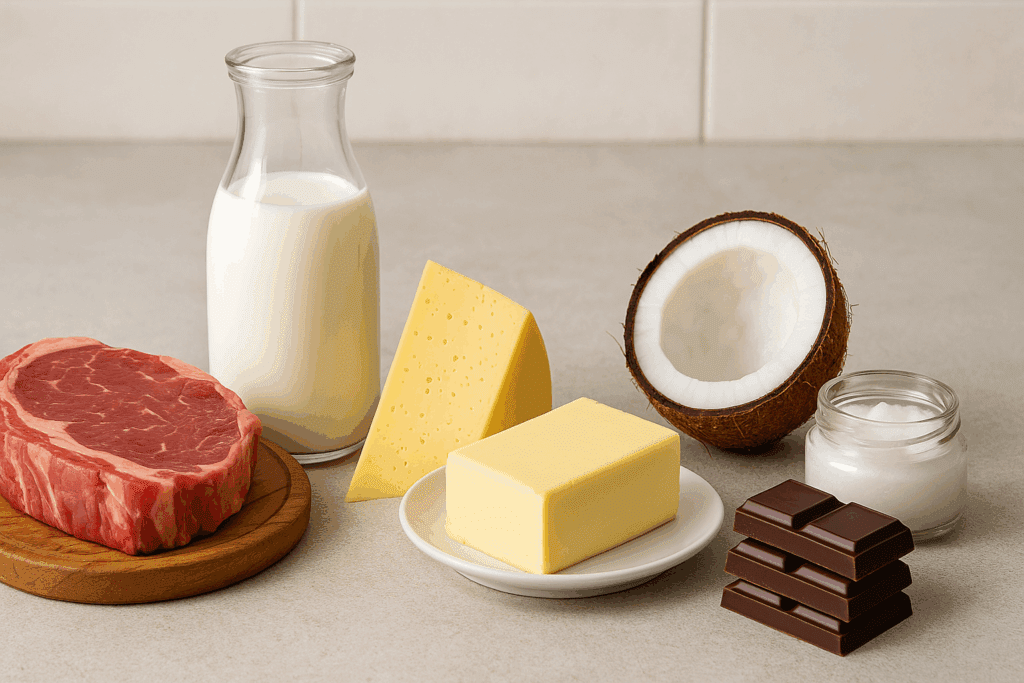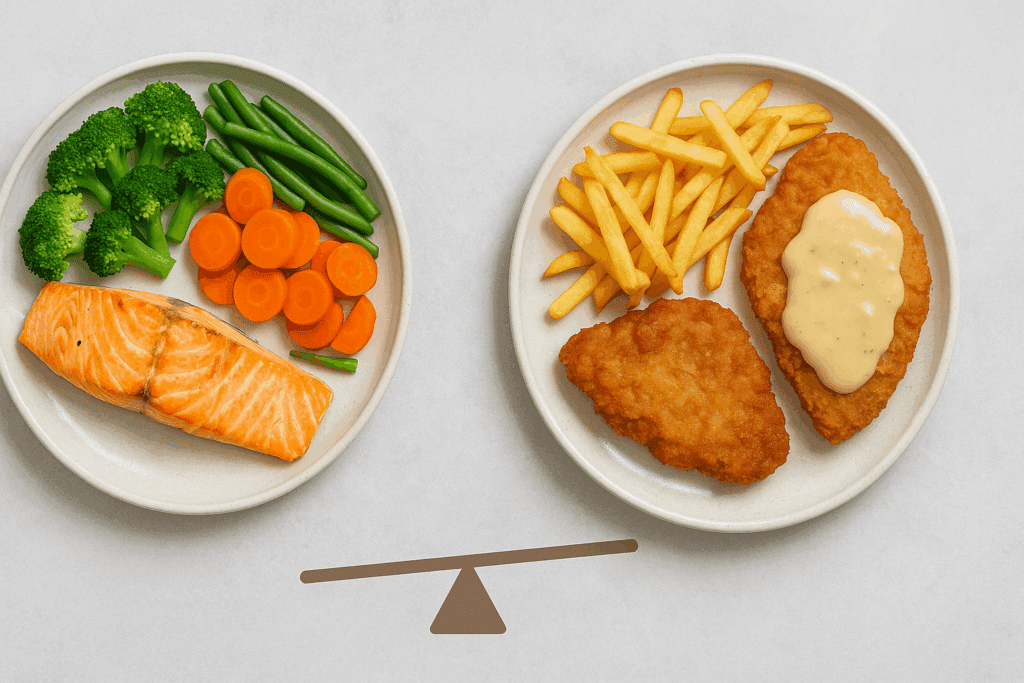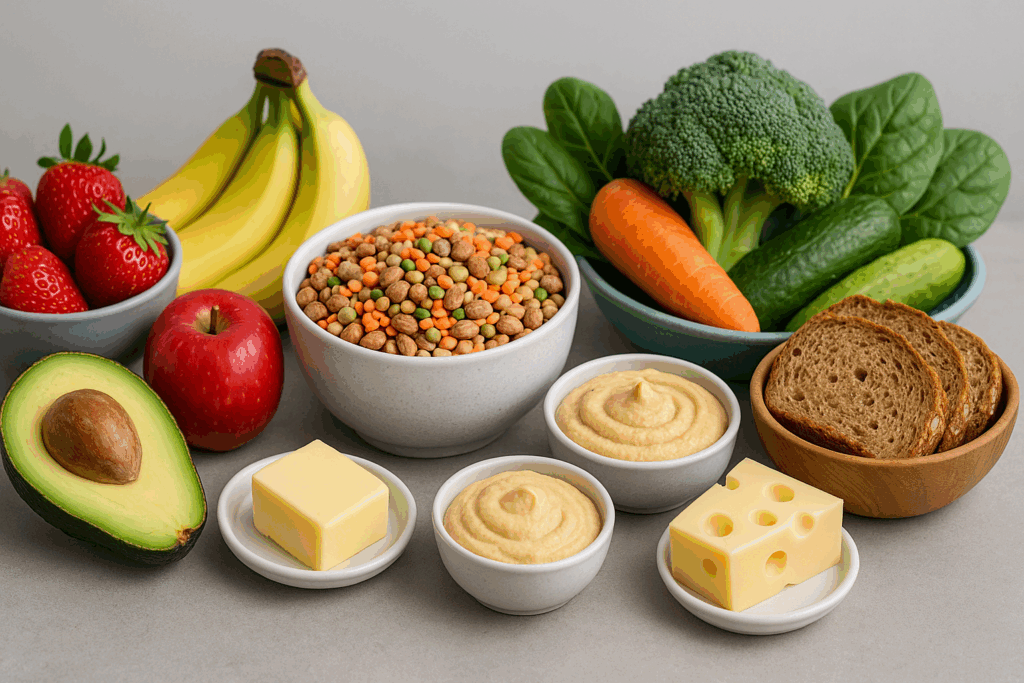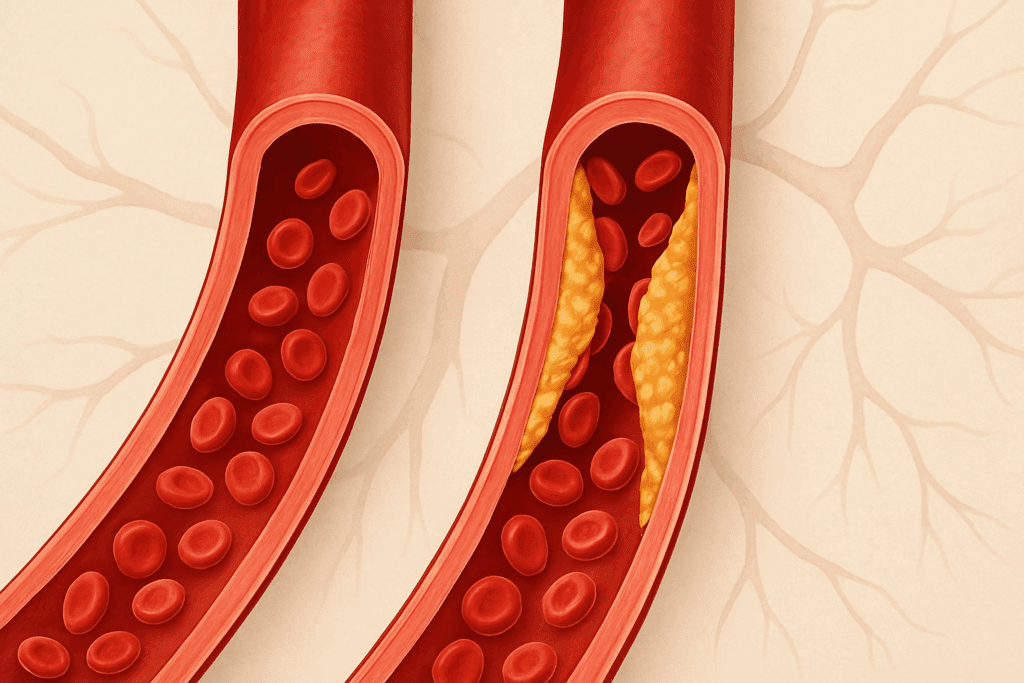Introduction: The Truth About Saturated Fat—Separating Science from Myth
Saturated fat has long been the subject of heated debates in nutrition science. From early warnings linking it to heart disease to more recent calls for balanced intake, the conversation around saturated fat continues to evolve. Yet many individuals still struggle to understand what saturated fat actually is, where it is found, and whether it poses a significant health risk. When we talk about saturated fatty acids food sources, most people picture greasy meals or fast food—but this is only part of the picture.
To truly make informed dietary decisions, it is essential to explore the saturated fat definition, understand its structural properties, identify saturated fat examples in everyday meals, and clarify what amount of calories makes something considered high fat. This article unpacks all of these elements to help readers gain clarity on how much is too much when it comes to saturated fat—and how to manage it without fear or confusion.
You may also like: Macronutrients vs Micronutrients: What the Simple Definition of Macronutrients Reveals About Your Diet and Health

Understanding the Definition and Structure of Saturated Fat
At its core, saturated fat refers to a type of fatty acid where all carbon atoms are saturated with hydrogen atoms. This chemical structure—no double bonds between carbon atoms—results in a fat that is typically solid at room temperature. When discussing saturated fat meaning, it’s important to understand that the term “saturated” describes the molecular saturation of hydrogen. These structural properties are what give saturated fats their stability and resistance to rancidity.
A saturated fatty acid has a simple chain-like structure, and when you explore saturated fatty acid structure example food items, you’ll find butter, coconut oil, and lard as textbook illustrations. These fats are widely used in cooking due to their texture and long shelf life. The definition of saturated fats in food is more than just a label—it is a reflection of the fat’s chemical properties, which influence its behavior during cooking and its effects on human health.
But what are saturated fats saturated with? Quite literally, they are saturated with hydrogen, leaving no room for additional bonds—making them more chemically stable than their unsaturated counterparts. While this stability is useful in food preservation, it’s also a key factor in understanding how these fats interact with our cardiovascular system.
What Does Saturated Fat Do in the Body?
The role of saturated fat in the human body is multifaceted. It is involved in cellular structure, hormone production, and the absorption of fat-soluble vitamins like A, D, E, and K. Despite these essential functions, saturated fat has gained notoriety due to its potential to raise LDL (“bad”) cholesterol levels, particularly when consumed in excess.
However, it is essential to understand that not all saturated fats affect the body equally. Some types, such as stearic acid—a saturated acid found in dark chocolate and lean meats—appear to have a neutral effect on cholesterol levels. Other types may increase LDL cholesterol but also raise HDL (“good”) cholesterol, complicating the narrative that all saturated fats are inherently harmful.
So, what does saturated fat do? It can support physiological processes when consumed moderately, but an excessive intake—particularly from processed foods—can contribute to inflammation and arterial plaque buildup. Understanding these distinctions is critical when evaluating whether saturated fat is beneficial or detrimental in specific dietary contexts.

Saturated Fat Examples in Common Foods
Saturated fats are found in a wide variety of both animal and plant-based foods. When asking what foods contain saturated fat, most people immediately think of red meats, butter, or full-fat dairy. While these are major sources, many less obvious foods also contain significant amounts of saturated fat.
Common saturated fatty acids food sources include fatty cuts of beef, pork, and lamb, along with dairy products such as cheese, cream, and whole milk. Coconut oil, palm oil, and cocoa butter are plant-based examples that are particularly high in saturated fat. Even seemingly healthy foods, such as granola bars or flavored yogurt, can be processed with ingredients rich in saturated lipids examples.
The term sta fat—a shorthand for saturated fat—often appears on nutrition labels. Recognizing this abbreviation can help consumers quickly identify hidden sources of saturated fat in processed or packaged foods. The key is to identify sample of saturated fats in everyday meals so they can be enjoyed in moderation without exceeding healthy intake levels.

How Much Saturated Fat Is Too Much?
Determining the right amount of saturated fat requires a closer look at daily caloric intake and nutritional guidelines. According to current health recommendations, the saturated fat daily value should not exceed 10% of total calories, with even stricter limits (below 7%) suggested for individuals with high cardiovascular risk.
So, what amount of calories makes something considered high fat? The FDA considers any food where more than 35% of its calories come from fat as high in fat. Specifically, for saturated fat, any food that delivers more than 20% of the recommended daily value per serving is deemed high in saturated fat.
Understanding these thresholds can help individuals avoid excessive intake. For example, a single tablespoon of butter contains about 7 grams of saturated fat—roughly one-third of the recommended daily limit on a 2,000-calorie diet. By tracking intake across meals and identifying what food sources are in saturated fat, consumers can ensure they remain within healthy limits.
Exploring Saturated Fatty Acids Examples and Food Sources
It is not only important to identify foods that have saturated fat but also to understand their place within the overall diet. Among the most common saturated fatty acids examples are lauric acid (found in coconut oil), palmitic acid (in palm oil and meat), and myristic acid (in dairy). Each of these saturated acids has a different metabolic effect and potential impact on cholesterol levels.
What are the sources of saturated fats? They can be broadly categorized into animal-based sources like beef, poultry skin, egg yolks, and full-fat dairy, as well as plant-based sources such as tropical oils. While some of these foods also provide valuable nutrients—like protein, calcium, and iron—others, especially processed options, offer little nutritional benefit.
In choosing between these options, it helps to evaluate what are two food sources of saturated fat that differ in health value. For instance, grass-fed beef may contain omega-3s and conjugated linoleic acid (CLA), while processed deli meats often contain sodium, nitrates, and preservatives alongside saturated fat—compounding their health risks.

Foods That Do Not Include Fatty Acids: Smart Substitutions
A critical strategy for managing saturated fat intake involves incorporating more foods that do not include fatty acids in significant amounts. These typically include plant-based, whole foods such as legumes, fruits, vegetables, and whole grains. Such foods are naturally low in total fat and saturated fat while being rich in fiber, antioxidants, and micronutrients.
Replacing high-fat ingredients with these options allows individuals to enjoy flavorful meals without compromising cardiovascular health. For example, using avocado in place of butter, or opting for hummus instead of cheese spreads, significantly reduces saturated fat intake. These swaps not only support heart health but also contribute to better digestion and long-term weight management.
By shifting dietary patterns to emphasize foods that do not include fatty acids, individuals can still enjoy rich, satisfying meals while adhering to nutrition guidelines. Understanding what food sources are in saturated fat empowers this transition by revealing hidden fats in common items.

Does Saturated Fat Raise Cholesterol? A Nuanced Answer
One of the most frequently asked questions in nutrition is: does saturated fat raise cholesterol? The short answer is yes—but only under certain conditions. Saturated fat can elevate LDL cholesterol, especially when it replaces unsaturated fats in the diet. However, recent research has emphasized that the source and context of saturated fat consumption matter immensely.
Some studies show that full-fat dairy may have a neutral or even beneficial effect on heart health due to its calcium, protein, and fermentation content. Conversely, saturated fat from processed meats is more likely to increase inflammation and contribute to cardiovascular disease. This is why it is important to examine saturated lipids examples in their entirety rather than isolate them based solely on fat content.
In assessing whether saturated fat is bad for cholesterol, we must consider the totality of the diet. Mediterranean-style eating patterns, for example, allow for small amounts of saturated fat while still reducing overall disease risk. The focus should be on improving dietary quality rather than eliminating one nutrient entirely.
Practical Tips for Managing Saturated Fat Intake
Making informed dietary decisions requires more than label reading—it involves intentional meal planning and cooking habits. When identifying what foods contain saturated fat, keep in mind that preparation methods matter. Grilling instead of frying, choosing lean cuts of meat, and trimming visible fat can make a significant difference.
Home cooking with olive oil or avocado oil instead of butter or shortening is a simple way to reduce saturated fatty acid intake. Additionally, exploring cuisines that rely on legumes, vegetables, and whole grains can expand the palate while naturally lowering fat intake.
When consuming a sample of saturated fats, such as cheese or dark chocolate, portion control and meal balance are key. Including fiber-rich sides or plant-based proteins helps counterbalance the effects of saturated fat and supports digestive and metabolic health.
Frequently Asked Questions: Saturated Fat, Nutrition, and Health
1. Can saturated fats ever be beneficial in specific diets or health contexts?
Yes, in certain situations, saturated fat may play a constructive role in balanced diets. For instance, in ketogenic and low-carbohydrate therapeutic diets used to manage epilepsy or metabolic syndrome, saturated fatty acids food sources like coconut oil and full-fat dairy are used to maintain satiety and support energy production. Additionally, emerging studies suggest that not all saturated fat examples carry the same health risks; for example, stearic acid may have a neutral impact on cholesterol. Rather than avoiding saturated acids altogether, some dietitians advocate for a nuanced view—prioritizing whole-food sources over highly processed items. Understanding how different saturated fatty acids examples affect the body helps tailor dietary approaches to individual needs.
2. Are there cultural or regional diets that include high saturated fat without negative outcomes?
Yes, several traditional diets incorporate saturated fatty acids food naturally and still support cardiovascular health. The diet of the Maasai in Kenya, for example, includes high saturated fat from milk and meat but has historically been linked to low rates of heart disease. Similarly, certain Pacific Island populations consume large amounts of coconut—a saturated fatty acid structure example food—yet demonstrate strong metabolic health. These cases highlight that what foods contain saturated fat is only part of the equation; physical activity, genetics, and overall dietary composition also shape outcomes. The key lesson is that saturated fats are saturated with what the entire lifestyle accommodates—not just the nutrient in isolation.
3. How can someone reduce saturated fat without sacrificing flavor or satisfaction?
Flavorful cooking doesn’t require excessive saturated fat. Instead of butter or lard, try sautéing vegetables in olive oil or using spices and citrus for bold taste. Replacing foods that have saturated fat like processed meats with grilled lean proteins or plant-based alternatives keeps meals satisfying. Legumes, mushrooms, and umami-rich ingredients can provide depth while reducing dependence on sta fat sources. For baked goods, mashed avocado or Greek yogurt can substitute for butter, aligning better with the saturated fat daily value targets. With a little creativity, it’s possible to maintain enjoyment while minimizing saturated lipids examples in your meals.
4. What practical strategies help identify hidden sources of saturated fat in packaged foods?
Label literacy is essential. Look beyond the obvious and examine ingredients lists for hydrogenated oils or palm derivatives, both of which are common saturated fatty acids food sources. Pay attention to portion sizes—what appears to be a moderate fat snack may exceed the recommended saturated fat daily value in multiple servings. Be aware that even products marketed as healthy, such as granola or meal replacement bars, can hide saturated fat examples through additives like coconut oil or whole milk powder. Familiarity with saturated fatty acids examples helps shoppers assess which foods that have saturated fat are significant contributors and which can be consumed in moderation.
5. How does saturated fat intake relate to mental health and cognition?
Recent studies are exploring how saturated fat may influence cognitive performance and emotional regulation. Some findings suggest that diets very high in saturated fatty acid could impair memory and increase inflammation in the brain, potentially exacerbating mood disorders. However, other research indicates that specific saturated fatty acids examples, like those found in MCT-rich coconut oil, may support brain function in Alzheimer’s patients. The answer likely lies in the type, source, and total amount consumed. Understanding what does saturated fat do in the brain is an emerging area of research with potential implications for dietary recommendations in neurological care.
6. Are there any public health policies regulating saturated fat in foods?
Yes, many countries have set limits and labeling requirements to guide saturated fat consumption. The U.S. FDA provides reference amounts for what amount of calories makes something considered high fat, helping consumers navigate food choices. In countries like Denmark and Chile, taxes and warning labels on high-fat products aim to reduce chronic disease rates. These measures are often based on population-level studies of what are the sources of saturated fats and how they impact national health metrics. Policymakers also encourage reformulation, prompting manufacturers to replace sta fat with healthier alternatives, improving overall food quality.
7. Can children and teenagers safely consume saturated fat?
Children need dietary fat for growth, but the emphasis should be on variety and moderation. While whole milk, eggs, and meat are foods that contain saturated fat, young individuals also benefit from unsaturated fats found in nuts, seeds, and fish. Pediatric dietary guidelines recommend limiting saturated fat while ensuring adequate total fat for brain and hormonal development. Because kids often consume fast food and snacks—common saturated lipids examples—careful planning is required to balance fat sources. Educating families on saturated fatty acid structure example food choices empowers healthier habits from a young age.
8. How do athletic performance and fitness goals relate to saturated fat consumption?
Athletes require sufficient dietary fat to support energy, muscle repair, and hormone synthesis. While many athletes avoid excessive saturated fatty acid, strategic use of saturated fat examples such as eggs or full-fat dairy can support strength training when integrated into a nutrient-dense diet. For endurance athletes, medium-chain triglycerides (a form of saturated fatty acids food) offer a quick fuel source during long training sessions. The balance lies in matching fat intake to energy expenditure and prioritizing foods that do not include fatty acids in excess when trying to cut weight. Fitness goals should align with total dietary quality, not just macronutrient ratios.
9. How does food processing affect the health impact of saturated fats?
Processing often changes how saturated fats are saturated with other compounds, affecting absorption and inflammation. For example, frying oils reused multiple times can produce harmful byproducts, even if the original oil was relatively stable. Saturated fat meaning differs greatly between raw whole foods and ultraprocessed meals loaded with additives. Some minimally processed saturated fatty acids examples, like raw cheese or unrefined coconut oil, retain beneficial nutrients and pose lower health risks. Understanding what food sources are in saturated fat and how they are altered by heat and chemicals can help consumers make informed decisions.
10. What does the future hold for saturated fat research and recommendations?
As research becomes more personalized, future guidelines will likely focus on genetic response, gut microbiome interactions, and food matrices rather than blanket limits. Scientists are increasingly examining how sample of saturated fats interact with other nutrients in the context of whole meals. For example, a saturated fat-laden meal rich in fiber and polyphenols may affect the body differently than one composed of refined grains and sugar. The evolving definition of saturated fats in food will include not just content, but quality, origin, and co-nutrient context. As we deepen our understanding of what are two food sources of saturated fat and how they influence disease risk, dietary advice will grow more sophisticated and tailored to individual health profiles.
Conclusion: Navigating Saturated Fat for Better Health and Wellness
Understanding the impact of saturated fat begins with scientific clarity and ends with practical application. By exploring what foods contain saturated fat, recognizing saturated fatty acids examples, and learning what amount of calories makes something considered high fat, individuals can approach their diet with confidence rather than confusion. The saturated fat definition—a fat saturated with hydrogen atoms—provides only the beginning of the story. The real power lies in knowing how this fat behaves in the body and in food.
Whether asking, does saturated fat raise cholesterol or trying to distinguish between helpful and harmful fats, the answer often depends on quantity, source, and individual health status. Foods that have saturated fat aren’t inherently harmful, but their place in the diet must be balanced with foods that do not include fatty acids, such as fruits, legumes, and whole grains. Reading labels, cooking at home, and understanding what food sources are in saturated fat are all crucial steps toward better health.
Rather than fear saturated fat, the goal should be to navigate it wisely. Empowered with knowledge about saturated lipids examples, the saturated fat daily value, and practical substitutions, we can build a diet that supports both heart health and long-term wellness—without sacrificing flavor, enjoyment, or nutritional adequacy.


